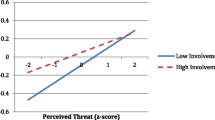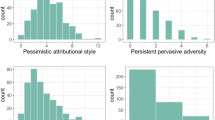Abstract
This study examined the concurrent and longitudinal relations among cumulative risk, appraisal, co**, and adjustment. Longitudinal path models were tested in a community sample of 316 children in preadolescence to examine hypotheses that threat appraisal and avoidant co** mediate the effects of cumulative risk on child adjustment, whereas positive appraisal and active co** were hypothesized to predict better adjustment independently. Children and their mothers were assessed during in-home interviews at three time points at one-year intervals. Children reported on appraisal and co** strategies. Mothers and children reported on child adjustment problems and positive adjustment. Rank-order changes in appraisal and co** predicted rank-order changes in adjustment. Cumulative risk was concurrently related to higher threat appraisal and avoidant co** at each time point. Threat appraisal and avoidant co** mediated the relations of cumulative risk to rank-order changes in adjustment. There is specificity in the relations of cumulative risk to threat appraisal and avoidant co**, whereas positive appraisal and active co** are independent of risk and operate as individual resource factors.

Similar content being viewed by others
References
Achenbach, T. M. (1991). Manual for the child behavior checklist and revised child behavior profile. Bulington, VT: University of Vermont Department of Psychiatry.
Aldridge, A. A., & Roesch, S. C. (2007). Co** and adjustment in children with cancer: A meta-analytic study. Journal of Behavioral Medicine, 30(2), 115–129.
Appleyard, K., Egeland, B., van Dulmen, M., & Sroufe, L. (2005). When more is not better: The role of cumulative risk in child behavior outcomes. Journal of Child Psychology and Psychiatry, 43, 235–245.
Atzaba-Poria, N., Picke, A., & Deater-Deckard, K. (2004). Do risk factors for problem behaviour act in a cumulative manner? An examination of ethnic minority and majority children through an ecological perspective. Journal of Child Psychology and Psychiatry, 45, 707–718.
Ayers, T., Sandler, I., West, S., & Roosa, M. (1996). A dispositional and situational assessment of children’s co**: Testing alternative models of co**. Journal of Personality, 64, 923–958.
Band, E., & Weisz, J. (1990). Developmental difference in primary and secondary control co** and adjustment to juvenile diabetes. Journal of Clinical Child and Adolescent Psychology, 19, 150–158.
Bronfenbrenner, U. (1979). Contexts of child rearing: Problems and prospects. American Psychologist, 34, 844–850.
Causey, D., & Dubow, E. (1992). Development of a self-report co** measure for elementary school children. Journal of Clinical Child Psychology, 21, 47–59.
Chen, E., Langer, D., Raphaelson, Y., & Mathews, K. (2004). Socioeconomic status and health in adolescents: The role of stress interpretations. Child Development, 75, 1039–1052.
Compas, B., Connor, J., Saltzman, H., Thomsen, A., & Wadsworth, M. (1999). Getting specific about co**: Effortful and involuntary responses to stress in development. Mahwah, NJ: Lawrence Erlabum Associates Inc.
Compas, B., Connor-Smith, J., Saltzman, H., Thomsen, A., & Wadsworth, M. (2001). Co** with stress during childhood and adolescence: Problems, progress, and potential in theory and research. Psychological Bulletin, 127, 87–127.
Compas, B., Malcarne, V., & Fondacaro, K. (1988). Co** with stressful events in older children and young adolescents. Journal of Consulting and Clinical Psychology, 56, 411–495.
Conduct Problems Prevention Research Group. (1991). Neighborhood questionnaire. Available: http://www.fasttrackproject.org.
Cummings, E. M., Davies, P. T., & Simpson, K. S. (1994). Marital conflict, gender, and children’s appraisals and co** efficacy as mediators of child adjustment. Journal of Family Psychology, 8(2), 141.
Dempsey, M. (2002). Negative co** as mediator in the relation between violence and outcomes: Inner-city African American youth. Journal of Orthopsychiatry, 72, 102–109.
Dodge, K., Bates, J., & Pettit, G. (1990). Mechanisms in the cycle of violence. Science, 250, 1678–1683.
Dodge, K. A., & Pettit, G. S. (2003). A biopsychosocial model of the development of chronic conduct problems in adolescence. Developmental Psychology, 39(2), 349.
Dumont, M., & Provost, M. (1999). Resilience in adolescents: Protective role of social support, co** strategies, self-esteem, and social activities on experience of stress and depression. Journal of Youth and Adolescence, 28, 343–363.
Ebata, A., & Moos, R. (1991). Co** and adjustment in distressed and healthy adolescents. Journal of Applied Developmental Psychology, 12, 33–54.
Ebata, A., & Moos, R. (1994). Personal, situational, and contextual correlates of co** in adolescence. Journal of Research on Adolescence, 4, 99–125.
Eisenberg, N., Fabes, R., & Guthrie, I. (1997). Co** with stress: The roles of regulation and development. In S. A. Wolchik & I. N. Sandler (Eds.), Handbook of children’s co**: Linking theory and intervention (pp. 41–70). New York: Pelnum.
Eisenberg, N., Guthrie, I., Fabes, R., Shepard, S., Losoya, S., Murphy, B., et al. (2000). Prediction of elementary school cihldren’s externalizing problem behaviors from attentional and behavioral regulation and negative emotionality. Child Development, 71, 1367–1382.
Evans, G. (2003). A multimethodological analysis of cumulative risk and allostatic load among rural children. Developmental Psychology, 39, 761–776.
Folkman, S. (2008). The case for positive emotions in the stress process. Anxiety, Stress, and Co**, 21, 3–14.
Gamble, W. (1994). Perceptions of controllability and other stressors event characteristics as determinants of co** among young adolescents and young adults. Journal of Youth and Adolescence, 23, 65–84.
Grant, K., Compas, B., Stuhlmacher, A., Thurm, A., McMahon, S., & Halpert, J. (2003). Stressors and child and adolescent psychopathology: Moving from markers to mechanisms of risk. Psychological Bulletin, 129, 447–466.
Grant, K., Compas, B., Thurm, A., McMahon, S., Gipson, P., Campbell, A., et al. (2006). Stressors and child and adolescent psychopathology: Evidence of moderating and mediating effects. Clinical Psychology Review, 26, 257–283.
Greenberg, M., Lengua, L., Coie, J., Pinderhughes, E., Bierman, K., Dodge, K., et al. (1999). Predicting developmental outcomes at school entry using a multiple-risk model: Four American communities. Developmental Psychology, 35, 403–417.
Gresham, F., & Elliot, S. (1990). Social skills rating system. Circle Pines, MN: American Guidance Service.
Grych, J., & Finchman, F. (1990). Marital conflict and children’s adjustment: A cognitive-contextual framework. Psychological Bulletin, 108, 267–290.
Grych, J., Finchman, F., Jouriles, E., & McDonald, R. (2000). Interparental conflict and child adjustment: Testing the mediational role of appraisal in the cognitive-contextual framework. Child Development, 71, 1648–1661.
Grych, J., Harold, G., & Miles, C. (2003). A prospective investigation of apprisals as mediators of the link between interparental conflict and childhood adjustment. Child Development, 74, 1176–1193.
Harter, S. (1982). The perceived competence scale for children. Child Development, 53, 87–97.
Jackson, Y., & Warren, J. (2000). Appraisal, social support, and life events: Predicting outcome behavior in school-age children. Child Development, 71, 1206–1217.
Jaser, S., Langrock, A., Keller, G., Merchant, M., Benson, M., Reeslund, K., et al. (2005). Co** with the stress of parental depression II: Adolescent and parent reports of co** and adjustment. Journal of Clinical Child and Adolescent Psychology, 34, 193–205.
Jerusalem, M., & Schwarzer, R. (1992). Self-efficacy as a resource factor in stress appraisal processes. In R. Schwarzer (Ed.), Self-efficacy : Thought control of action. Washington, D.C.: Hemisphere Publishing Corporation.
Kliewer, W., Parrish, K., Taylor, K., Jackson, K., Walker, J., & Shivy, V. (2006). Socialization of co** with community violence: Influences of caregiver coaching, modeling, and family context. Child Development, 77, 605–623.
Kopp, C. B. (1989). Regulation of distress and negative emotions: A developmental view. Developmental Psychology, 25, 343–354.
Kovacs, M. (1981). Rating scales to assess depression in school aged children. Acta Paedopsychiatry, 46, 305–315.
Landis, D., Gaylord-Harden, N., Malinowski, S., Grant, K., Carleton, R., & Ford, R. (2007). Urban adolescent stress and hopelessness. Journal of Adolescence, 30, 1051–1070.
Lazarus, R., & Folkman, S. (1984). Stress, appraisal and co**. New York, NY: Springer.
Lengua, L., Bush, N., Long, A., Trancik, A., & Kovacs, E. (2008). Effortful control as a moderator of the relation between contextual risk and growth in adjustment problems. Development and Psychopathology, 20, 509–528.
Lengua, L., & Long, A. (2002). The role of emotionality and self-regulation in the appraisal-co** process: Tests of direct and moderating effects. Applied Developmental Psychology, 23, 471–493.
Lengua, L., Sandler, I., West, S., Wolchik, S., & Curran, P. (1999). Emotionality and self-regulation, threat appraisal, and co** in children of divorce. Development and Psychopathology, 11, 15–37.
Merikangas, K. R., Nakamura, E. F., & Kessler, R. C. (2009). Epidemiology of mental disorders in children and adolescents. Dialogues in clinical neuroscience, 11(1), 7–20.
Muthén, L., & Muthén, B. (2010). Mplus user’s guide (6th ed.). Los Angeles, CA: Múthen & Múthen.
Petterson, S., & Albers, A. (2001). Effects of poverty and maternal depression on early child development. Child Development, 72, 1794–1813.
Radloff, L. (1977). The CES-D Scale: A self-report depression scale for research in the general population. Applied Psychological Measurement, 1, 385–401.
Repetti, R., Taylor, S., & Seeman, T. E. (2002). Risky families: Family social environments and the mental and physical health of offspring. Psychological Bulletin, 128, 330–366.
Rutter, M. (1979). Protective factors in children’s responses to stress and disadvantage. In M. W. Kent & J. E. Rolf (Eds.), Primary prevention of psychopathology: Social competence in children (Vol. 3, pp. 49–74). Hanover, NH: University Press of New England.
Sameroff, A., Seifer, R., Barocas, R., Zax, M., & Greenspan, S. (1987). Intelligence quotient scores of 4-year-old children: Social-environmental risk factors. Pediatrics, 79, 343–350.
Sandler, I., Kim-Bae, L., & MacKinnon, D. (2000). Co** and negative appraisals as mediators between control beliefs and psychological symptoms in children of divorce. American Journal of Community Psychology, 19, 501–520.
Sandler, I., Ramirez, R., & Reynolds, K. D. (1986). Life stress for children of divorce, bereaved, and asthmatic children. Paper presented at the annual meeting of the American Psychological Association, Washington, DC.
Sandler, I., Tien, J., & West, S. (1994). Co**, stress, and the psychological symptoms of children of divorce: A cross-sectional and longitudinal study. Child Development, 65, 1744–1763.
Seiffge-Krenke, I. (2000). Causal links between stressful events, co** style, and adolescent symptomatology. Journal of Adolescence, 23, 675–691.
Seiffge-Krenke, I., Aunola, K., & Nurmi, J. (2009). Changes in stress perception and co** during adolescence: The role of situational and personal factors. Child Development, 80(1), 259–279.
Sheets, V., Sandler, I., & West, S. (1996). Appraisals of negative events by preadolescent children of divorce. Child Development, 67, 2166–2182.
Skinner, E., & Zimmer-Gembeck, M. (2007). The development of co**. Annual Review of Psychology, 58, 119–144.
Taylor, R., & Shumaker, S. (1990). Local crime as a natural hazard: Implications for understanding the relationship between disorder and fear of crime. American Journal of Community Psychology, 18, 619–641.
Troy, A., Wilhelm, F., Shallcross, A., & Mauss, I. (2010). Seeing the silver lining: Cognitive reappraisal ability moderates the relationship between stress and depressive symptoms. Emotion, 10, 783.
Valentiner, D. P., Holahan, C. J., & Moos, R. (1994). Social support, appraisals of event controllability, and co**: An integrative model. Journal of Personality and Social Psychology, 66(6), 1094–1102.
Veit, C., & Ware, J. (1983). The structure of psychological distress and well being in general populations. Journal of Consulting and Clinical Psychology, 51, 730–742.
Wadsworth, M., & Berger, L. (2006). Adolescents co** with poverty-related family stress: Prospective predictors of co** and psychological symptoms. Journal of Youth and Adolescence, 35(1), 57–70.
Wadsworth, M., & Compas, B. (2002). Co** with family conflic and economic strain: The adolescent perspective. Journal of Adolescence, 12, 243–274.
Wadsworth, M., Raviv, T., Compas, B., & Connor-Smith, J. (2005). Parent and adolescent responses to poverty-related stress: Tests of mediated and moderated co** models. Journal of Child and Family Studies, 14, 283–298.
Wandersman, A., & Nation, M. (1998). Urban neighborhoods and mental health. Psychological contributions to understanding toxicity, resilience, and interventions. American Psychologist, 53, 647–656.
Acknowledgments
This study was supported by grants awarded to Liliana Lengua from the National Institute of Mental Health (#R29MH57703) and from the University of Washington Royalty Research Fund. The authors thank the families who participated in this research.
Author information
Authors and Affiliations
Corresponding author
Rights and permissions
About this article
Cite this article
Thompson, S.F., Lengua, L.J. & Garcia, C.M. Appraisal and Co** as Mediators of the Effects of Cumulative Risk on Preadolescent Adjustment. J Child Fam Stud 25, 1416–1429 (2016). https://doi.org/10.1007/s10826-015-0338-9
Published:
Issue Date:
DOI: https://doi.org/10.1007/s10826-015-0338-9




